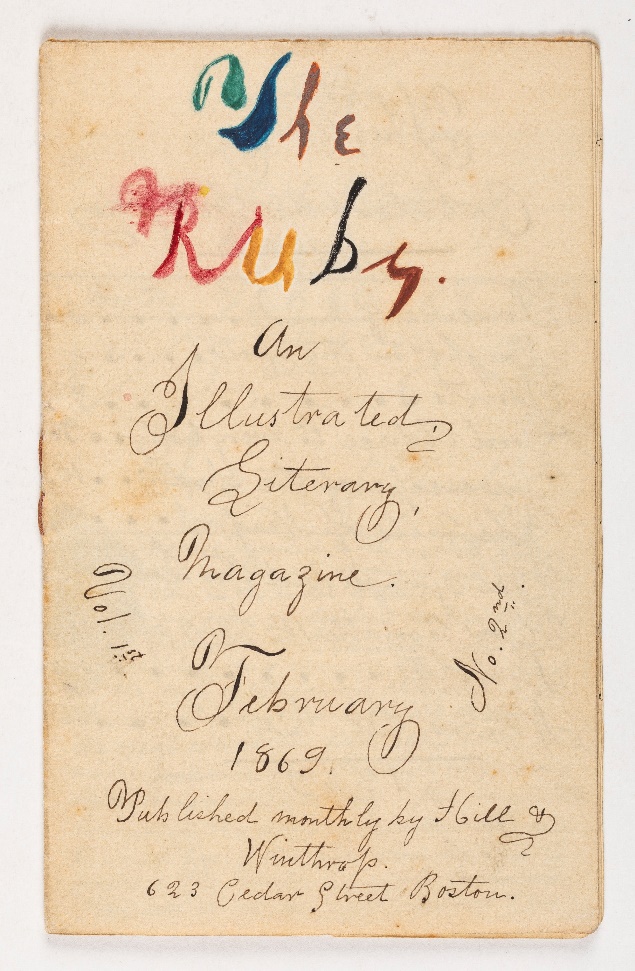Most of the manuscript newspapers in the Historic Children's Voices grant include copied and original poetry written by children. Whether the newspapers were created as a school or personal project, poetry is widely featured in them. Two example that best illustrate this are The Ruby, published by Hill & Winthrop, and The Roarer, published by an unidentified child. These newspapers demonstrate the creativity and interests of 19th century children as they lived out their lives.
The Ruby

The Ruby was published by Hill & Winthrop of Boston and edited by George Winthrop Pratt in 1869. While there is very little information about them, it is believed that this newspaper was a personal project created by two child friends. This colorful paper includes articles about animals and hiking, local notices, anecdotes such as "The Escape of the Spider" and "The Judge and the Lawyer," and poetry. The poem they wrote was titled "The Falls of Niagara" and describes the fascination of the editor with the natural beauty of the falls. He writes, "Falls! How beautiful! Your waters rush, and headlong crash, They seem to leap, down in a heap, My tongue doth fail, to tell your tale, I should be dumb I know." It is through short poems like these that children developed their literary and writings skills and shared with others their interests and fascinations.
Boston in the mid-19th century flourished culturally. There were many literary residents living in the city, including writers Nathaniel Hawthorne, James Russell Lowell, and Julia Ward Howe, historians such as George Bancroft and William Hickling Prescott, and philosophers like Ralph Waldo Emerson and Mary Baker Eddy. There were also many famous publishers, including Houghton Mifflin, Harvard University Press, and Little, Brown and Company, who published widely circulated magazines like The Atlantic Monthly. Higher education also flourished in this period, with the founding of Boston College in 1863 and the Massachusetts Institute of Technology (MIT) in 1865.
The Roarer
 The Roarer was published in Bridgewater, Mass. in 1841 by an unidentified editor. The only indication given reads "Printed and sold at the ofice [i.e., office] a letle [i.e., little] south of the log cabin in the maple grove near a big root." The paper included joke advertisements, local notices, and poetry. The editor describes an imagined story in the first poem about becoming the editor of the paper and distributing it around. He writes in the first two stanzas, "I put my pen into the ink, All on account of the rooster, But I don’t want any thing to think, I am in any thing of a fluster. I have merely taken up opposition, To let folks know I am a snorer, Some will call it a composition, I call it the ring tail roarer." The poetry included in the paper have this humorous and playful tone and show the range of different poems that children wrote. They wrote poetry that complimented the tone and purpose of their newspaper.
The Roarer was published in Bridgewater, Mass. in 1841 by an unidentified editor. The only indication given reads "Printed and sold at the ofice [i.e., office] a letle [i.e., little] south of the log cabin in the maple grove near a big root." The paper included joke advertisements, local notices, and poetry. The editor describes an imagined story in the first poem about becoming the editor of the paper and distributing it around. He writes in the first two stanzas, "I put my pen into the ink, All on account of the rooster, But I don’t want any thing to think, I am in any thing of a fluster. I have merely taken up opposition, To let folks know I am a snorer, Some will call it a composition, I call it the ring tail roarer." The poetry included in the paper have this humorous and playful tone and show the range of different poems that children wrote. They wrote poetry that complimented the tone and purpose of their newspaper.
Bridgewater, Mass. in the mid-19th century was an industrial site for the manufacture of cotton gins. The Southern Cotton Gin Co. operated at 42 Spring St. from 1840 to 1880. Another important industry was iron casting and forging, done by the Bridgewater Iron Manufacturing Company. They were one of the largest ironworks at the time, and further expanded with the introduction of a railroad connection with Boston in 1845.
Suggested Classroom Questions and Activities
- What kind of topics did children include in their poems?
- In what style did children write their poems?
- Ask your students to write their own poem on a topic that they're interested in, something they like, or describing a real or fictional anecdote.
To expand, ask your students to distribute copies of their poem with class.
(CCSS.ELA-LITERACY.RL.4.2 Determine a theme of a story, drama, or poem from details in the text; summarize the text.)
(CCSS.ELA-LITERACY.W.4.4 Produce clear and coherent writing in which the development and organization are appropriate to task, purpose, and audience.)